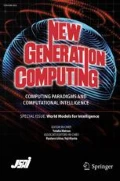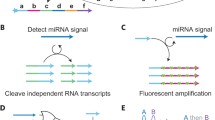Abstract
We developed a reaction system to generate multiple single-stranded DNA species at a physiological temperature for controlling the operation of DNA nanomachines. In this reaction system, cascading DNA generation is arbitrarily programmed by permutation and altering the combinations of template DNA sequences in a modular fashion. Because the dissociation of generated DNA strands from their templates is fully dependent on the strand displacement activity of DNA polymerase, generation and subsequent hybridization of DNA strands can be implemented in a one-pot reaction at the reaction temperature. We experimentally confirmed the generation and hybridization of DNA strands at a temperature remarkably lower than the melting temperature by monitoring the fluorescence change caused by the structural transition of molecular beacons as a simple DNA nanomachine operation. Then, we demonstrated the versatility and programmability of the cascading DNA generation up to three layers. By integrating the proposed DNA generation reaction with various types of DNA nanomachines, an intelligent molecular robotic system is expected to be achieved.
Similar content being viewed by others
References
Seeman N.C.: “DNA in a material world,”. Nature 421, 427–431 (2003)
Rothemund P.W.K.: “Folding DNA to create nanoscale shapes and patterns,”. Nature 440, 297–302 (2006)
He Y., Ye T., Su M., Zhang C., Ribbe A.E., Jiang W., Mao C.: “Hierarchical self-assembly of DNA into symmetric supramolecular polyhedra,”. Nature 452, 198–202 (2008)
Wei B., Dai M., Yin P.: “Complex shapes self-assembled from single-stranded DNA tiles,”. Nature 485, 623–626 (2012)
Bath J., Turberfield A.J.: “DNA nanomachines,”. Nature Nanotech. 2, 275–284 (2007)
Yurke B., Turberfield A.J., Mills A.P. Jr, Simmel F.C., Neumann J.L.: “A DNA-fuelled molecular machine made of DNA,”. Nature 406, 605–608 (2000)
Shin J.-S., Pierce N.A.: “A synthetic DNA walker for molecular transport,”. J. Am. Chem. Soc. 126, 10834–10835 (2004)
Gu H., Chao J., Xiao S.-J, Seeman N.C.: “A proximity-based programmable DNA nanoscale assembly line,”. Nature 465, 202–205 (2010)
Murata S., Konagaya A., Kobayashi S., Saito H., Hagiya M.: “Molecular robotics: a new paradigm for artifacts,”. New Gener. Comput. 31, 27–45 (2013)
Hagiya M., Konagaya A., Kobayashi S., Saito H., Murata S.: “Molecular robots with sensors and intelligence,”. Acc. Chem. Res. 47, 1681–1690 (2014)
Tyagi S., Kramer F.R.: “Molecular beacons: probes that fluoresce upon hybridization,”. Nature Biotechnol. 14, 303–308 (1996)
Seelig G., Soloveichik D., Zhang D.Y., Winfree E.: “Enzyme-free nucleic acid logic circuits,”. Science 314, 1585–1588 (2006)
Walker G.T., Little M.C., Nadeau J.G., Shank D.D.: “Isothermal in vitro amplification of DNA by a restriction enzyme/DNA polymerase system,”. Proc. Natl. Acad. Sci. USA 89, 392–396 (1992)
Matsuda D., Yamamura M.: “Cascading whiplash PCR with a nicking enzyme,”. Lect. Notes in Comp. Sci. 2568, 38–46 (2003)
Van Ness J., Van Ness L.K., Galas D.J.: “Isothermal reactions for the amplification of oligonucleotides,”. Proc. Natl. Acad. Sci. USA 100, 4504–4509 (2003)
Weizmann Y., Beissenhirtz M.K., Cheglakov Z., Nowarski R., Kotler M., Willner I.: “A virus spotlighted by an autonomous DNA machine,”. Angew. Chem., Int. Ed. 45, 7384–7388 (2006)
Montagne, K., Plasson, R., Sakai, Y., Fujii, T. and Rondelez, Y., “Programming an in vitro DNA oscillator using a molecular networking strategy,” Mol. Sys. Biol., 7, Article Number 466, 2011
Markham N.R., Zuker M.: “DINAMelt web server for nucleic acid melting prediction,”. Nucleic Acids Res. 33, W577–W581 (2005)
Tsourkas A., Behlke M.A., Rose S.D., Bao G.: “Hybridization kinetics and thermodynamics of molecular beacons,”. Nucleic Acids Res. 31, 1319–1330 (2003)
Yurke B., Millis A.P. Jr.: “Using DNA to power nanostructures,”. Genetic Programming and Evolvable Machines 4, 111–122 (2003)
Zhang D.Y., Winfree E.: “Control of DNA strand displacement kinetics using toehold exchange,”. J. Am. Chem. Soc. 131, 17303–17314 (2009)
Komiya K., Yamamura M., Rose J.A.: “Experimental validation and optimization of signal dependent operation in whiplash PCR,”. Natural Computing 9, 207–218 (2010)
Author information
Authors and Affiliations
Corresponding author
About this article
Cite this article
Komiya, K., Yamamura, M. Cascading DNA Generation Reaction for Controlling DNA Nanomachines at a Physiological Temperature. New Gener. Comput. 33, 213–229 (2015). https://doi.org/10.1007/s00354-015-0304-5
Received:
Revised:
Published:
Issue Date:
DOI: https://doi.org/10.1007/s00354-015-0304-5




